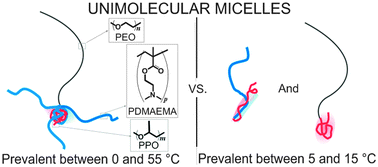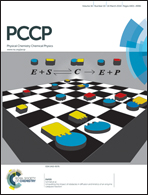Effects of architecture on the stability of thermosensitive unimolecular micelles†
Abstract
The influence of architecture on polymer interactions is investigated and differences between branched and linear copolymers are found. A comprehensive picture is drawn with the help of a fluorescence approach (using pyrene and 4HP as probe molecules) together with IR or NMR spectroscopy and X-ray/light scattering measurements. Five key aspects are addressed: (1) synergistic intramolecular complexation within miktoarm stars. The proximity of thermoresponsive poly(propylene oxide) (PPO) and poly(dimethylaminoethyl methacrylate) (PDMAEMA) within a miktoarm star leads to complexation between these weakly interacting partners. Consequently, the original properties of the constituents are lost, showing hydrophobic domains even at low temperatures, at which all homopolymers are water soluble. (2) Unimolecular micelles for miktoarm stars. The star does not exhibit intermolecular self-assembly in a large temperature range, showing unimers up to 55 °C. This behavior was traced back to a reduced interfacial tension between the PPO–PDMAEMA complex and water (PDMAEMA acts as a “microsurfactant”). (3) Unimolecular to multimolecular micelle transition for stars. The otherwise stable unimolecular micelles self-assemble above 55 °C. This aggregation is not driven by PPO segregation, but by collapse of residual PDMAEMA. This leads to micrometer-sized multilamellar vesicles stabilized by poly(ethylene oxide) (PEO). (4) Prevention of pronounced complexation within diblock copolymers. In contrast to the star copolymers, PPO and PDMAEMA adapt rather their homopolymer behavior within the diblock copolymers. Then they show their immanent LCST properties, as PDMAEMA turns insoluble at elevated temperatures, whereas PPO becomes hydrophobic below room temperature. (5) Two-step micellization for diblock copolymers. Upon heating of linear copolymers, the dehydration of PPO is followed by self-assembly into spherical micelles. An intermediate prevalence of unimolecular micelles is revealed in a small temperature window between PPO collapse and self-assembly of PEO-b-PPO. Also for PPO-b-PDMAEMA, PPO segregation prevails after initial weak complexation, leading to micelles with a PPO core. Considerable amounts of water are entrapped within the collapsed PDMAEMA domains above 55 °C (skin effect), preventing PPO–PDMAEMA complexation within precipitating PPO-b-PDMAEMA. Further, collapsed PDMAEMA is rather polar as sensed by pyrene and 4HP. In summary, advanced macromolecular architectures can lead to an unprecedented intramolecular self-assembly behavior, where internal complexation prevents intermolecular aggregation.


 Please wait while we load your content...
Please wait while we load your content...